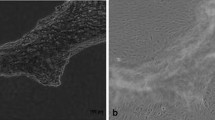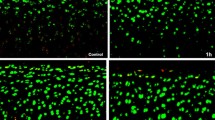Abstract
Background
Intraarticular injections of corticosteroids combined with local anesthetics are commonly used for management of chronic pain symptoms associated with degenerative joint diseases and after arthroscopic procedures. Several studies suggest chondrotoxicity of local anesthetics whereas others report chondroprotective and cytotoxic effects of corticosteroids on cartilage. Given the frequency of use of these agents, it is important to know whether they are in fact toxic.
Questions/purposes
We asked whether (1) bupivacaine and triamcinolone acetonide, alone and combined, were chondrotoxic to chondrocytes in culture; (2) buffering of the reagents diminished toxicity of the bupivacaine and triamcinolone; and (3) the presence of the superficial layer of articular cartilage protects against toxicity.
Materials and Methods
We obtained cartilage from three patients undergoing arthroplasty. To address triamcinolone acetonide, bupivacaine, and combinatorial toxicity to human chondrocytes, we set up monolayer chondrocyte cultures (n = 8 wells per condition). The question of buffering was addressed by performing the same assays as above, but the reagents were buffered. An MTT assay was used to assess chondrocyte survival in the monolayer. We harvested 21 articular plugs from each of three patients (total 63 plugs) and exposed them to the same reagents as above, including the buffered reagents. A Live/Dead assay was used to determine chondrocyte survival.
Results
Triamcinolone acetonide, bupivacaine, and their combination were toxic to human chondrocytes in the monolayer comparisons. The addition of buffering did not mitigate chondrocyte death. With the intact superficial layer in the plug group, bupivacaine was not toxic as compared with for the control group; all the other reagents (triamcinolone, combination bupivacaine/triamcinolone, buffered bupivacaine, buffered triamcinolone, and buffered combination) produced chondrotoxicity.
Conclusions
Triamcinolone induced chondrotoxicity in the articular plug and monolayer culture, whereas bupivacaine induced chondrotoxicity only in monolayer culture. The combined used of triamcinolone and bupivacaine did not show additive chondrocyte death in any arm. Buffering of bupivacaine increased its chondrotoxicity.
Clinical Relevance
Although not necessarily reflecting in vivo conditions, our data suggest physicians should be cognizant of the potential in vitro chondrotoxicity of bupivacaine and triamcinolone when contemplating intraarticular administration.


Similar content being viewed by others
References
Anz A, Smith MJ, Stoker A, Linville C, Markway H, Branson K, Cook JL. The effect of bupivacaine and morphine in a coculture model of diarthrodial joints. Arthroscopy. 2009;25:225–231.
Arroll B, Goodyear-Smith F. Corticosteroid injections for osteoarthritis of the knee: meta-analysis. BMJ. 2004;328:869.
Bellamy N, Campbell J, Robinson V, Gee T, Bourne R, Wells G. Intraarticular corticosteroid for treatment of osteoarthritis of the knee. Cochrane Database Syst Rev. 2006;19:CD005328.
Bigeleisen PE, Wempe M. Identification of the precipitate in alkalinized solutions of mepivacaine and bupivacaine at 37 degrees C. J Clin Pharm Ther. 2001;26:171–173.
Bolt DM, Ishihara A, Weisbrode SE, Bertone AL. Effects of triamcinolone acetonide, sodium hyaluronate, amikacin sulfate, and mepivacaine hydrochloride, alone and in combination, on morphology and matrix composition of lipopolysaccharide-challenged and unchallenged equine articular cartilage explants. Am J Vet Res. 2008;69:861–867.
Cardone DA, Tallia AF. Diagnostic and therapeutic injection of the hip and knee. Am Fam Physician. 2003;67:2147–2152.
Céleste C, Ionescu M, Robin Poole A, Laverty S. Repeated intraarticular injections of triamcinolone acetonide alter cartilage matrix metabolism measured by biomarkers in synovial fluid. J Orthop Res. 2005;23:602–610.
Centeno LM, Moore ME. Preferred intraarticular corticosteroids and associated practice: a survey of members of the American College of Rheumatology. Arthritis Care Res. 1994;7:151–155.
Cheney PR, Molzen G, Tandberg D. The effect of pH buffering on reducing the pain associated with subcutaneous infiltration of bupivicaine. Am J Emerg Med. 1991;9:147–148.
Christoph RA, Buchanan L, Begalla K, Schwartz S. Pain reduction in local anesthetic administration through pH buffering. Ann Emerg Med. 1988;17:117–120.
Chu CR, Izzo NJ, Coyle CH, Papas NE, Logar A. The in vitro effects of bupivacaine on articular chondrocytes. J Bone Joint Surg Br. 2008;90:814–820.
Chu CR, Izzo NJ, Papas NE, Fu FH. In vitro exposure to 0.5% bupivacaine is cytotoxic to bovine articular chondrocytes. Arthroscopy. 2006;22:693–699.
Cole BJ, Schumacher HR Jr. Injectable corticosteroids in modern practice. J Am Acad Orthop Surg. 2005;13:37–46.
Cummings NA, Nordby GL. Measurement of synovial fluid pH in normal and arthritic knees. Arthritis Rheum. 1966;9:47–56.
Davies RJ. Buffering the pain of local anaesthetics: a systematic review. Emerg Med (Fremantle). 2003;15:81–88.
Dragoo JL, Korotkova T, Kanwar R, Wood B. The effect of local anesthetics administered via pain pump on chondrocyte viability. Am J Sports Med. 2008;36:1484–1488.
Eggli PS, Hunziker EB, Schenk RK. Quantitation of structural features characterizing weight- and less-weight-bearing regions in articular cartilage: a stereological analysis of medial femoral condyles in young adult rabbits. Anat Rec. 1988;222:217–227.
Frías G, Caracuel MA, Escudero A, Rumbao J, Pérez-Gujo V, del Carmen Castro M, Font P, Gonzalez J, Collantes E. Assessment of the efficacy of joint lavage versus joint lavage plus corticoids in patients with osteoarthritis of the knee. Curr Med Res Opin. 2004;20:861–867.
Fubini SL, Todhunter RJ, Burton Wurster N, Vernier-Singer M, Macleod JN. Corticosteroids alter the differentiated phenotype of articular chondrocytes. J Orthop Res. 2001;19:688–695.
Gibson T, Burry HC, Poswillo D, Glass J. Effect of intra-articular corticosteroid injections on primate cartilage. Ann Rheum Dis. 1977;36:74–79.
Godwin M, Dawes M. Intra-articular steroid injections for painful knees: systematic review with meta-analysis. Can Fam Physician. 2004;50:241–248.
Gomoll AH, Kang RW, Williams JM, Bach BR, Cole BJ. Chondrolysis after continuous intra-articular bupivacaine infusion: an experimental model investigating chondrotoxicity in the rabbit shoulder. Arthroscopy. 2006;22:813–819.
Greis PE, Legrand A, Burks RT. Bilateral shoulder chondrolysis following arthroscopy: a report of two cases. J Bone Joint Surg Am. 2008;90:1338–1344.
Hanna MN, Elhassan A, Veloso PM, Lesley M, Lissauer J, Richman JM, Wu CL. Efficacy of bicarbonate in decreasing pain on intradermal injection of local anesthetics: a meta-analysis. Reg Anesth Pain Med. 2009;34:122–125.
Hansen BP, Beck CL, Beck EP, Townsley RW. Postarthroscopic glenohumeral chondrolysis. Am J Sports Med. 2007;35:1628–1634.
Hepper CT, Halvorson JJ, Duncan ST, Gregory AJ, Dunn WR, Spindler KP. The efficacy and duration of intra-articular corticosteroid injection for knee osteoarthritis: a systematic review of level I studies. J Am Acad Orthop Surg. 2009;17:638–646.
Karpie JC, Chu CR. Lidocaine exhibits dose- and time-dependent cytotoxic effects on bovine articular chondrocytes in vitro. Am J Sports Med. 2007;35:1621–1627.
Koyonos L, Yanke AB, McNickle AG, Kirk SS, Kang RW, Lewis PB, Cole BJ. A randomized, prospective, double-blind study to investigate the effectiveness of adding DepoMedrol to a local anesthetic injection in postmeniscectomy patients with osteoarthritis of the knee. Am J Sports Med. 2009;37:1077–1082.
Levy JC, Virani NA, Frankle MA, Cuff D, Pupello DR, Hamelin JA. Young patients with shoulder chondrolysis following arthroscopic shoulder surgery treated with total shoulder arthroplasty. J Shoulder Elbow Surg. 2008;17:380–388.
Lo IK, Sciore P, Chung M, Liang S, Boorman RB, Thornton GM, Rattner JB, Muldrew K. Local anesthetics induce chondrocyte death in bovine articular cartilage disks in a dose- and duration-dependent manner. Arthroscopy. 2009;25:707–715.
Nakazawa F, Matsuno H, Yudoh K, Watanabe Y, Katayama R, Kimura T. Corticosteroid treatment induces chondrocyte apoptosis in an experimental arthritis model and in chondrocyte cultures. Clin Exp Rheumatol. 2002;20:773–781.
Papachristou G, Anagnostou S, Katsorhis T. The effect of intraarticular hydrocortisone injection on the articular cartilage of rabbits. Acta Orthop Scand Suppl. 1997;275:132–134.
Pelletier JP, DiBattista JA, Raynauld JP, Wilhelm S, Martel-Pelletier J. The in vivo effects of intraarticular corticosteroid injections on cartilage lesions, stromelysin, interleukin-1, and oncogene protein synthesis in experimental osteoarthritis. Lab Invest. 1995;72:578–586.
Pelletier JP, Mineau F, Raynauld JP, Woessner JF Jr, Gunja-Smith Z, Martel-Pelletier J. Intraarticular injections with methylprednisolone acetate reduce osteoarthritic lesions in parallel with chondrocyte stromelysin synthesis in experimental osteoarthritis. Arthritis Rheum. 1994;37:414–423.
Petty DH, Jazrawi LM, Estrada LS, Andrews JR. Glenohumeral chondrolysis after shoulder arthroscopy: case reports and review of the literature. Am J Sports Med. 2004;32:509–515.
Piper SL, Kim HT. Comparison of ropivacaine and bupivacaine toxicity in human articular chondrocytes. J Bone Joint Surg Am. 2008;90:986–991.
Raynauld JP, Buckland-Wright C, Ward R, Choquette D, Haraoui B, Martel-Pelletier J, Uthman I, Khy V, Tremblay JL, Bertrand C, Pelletier JP. Safety and efficacy of long-term intraarticular steroid injections in osteoarthritis of the knee: a randomized, double-blind, placebo-controlled trial. Arthritis Rheum. 2003;48:370–377.
Richmond CE. Alkalinization of local anaesthetic for intra-articular instillation during arthroscopy. Br J Anaesth. 1994;73:190–193.
Robion FC, Doizé B, Bouré L, Marcoux M, Ionescu M, Reiner A, Poole AR, Laverty S. Use of synovial fluid markers of cartilage synthesis and turnover to study effects of repeated intra-articular administration of methylprednisolone acetate on articular cartilage in vivo. J Orthop Res. 2001;19:250–258.
Saunders S. Injection techniques: lower limb. In Saunders S, ed. Injection Techniques in Orthopaedic and Sports Medicine. 2nd ed. Philadelphia, PA: WB Saunders; 2002:69–90.
Seshadri V, Coyle CH, Chu CR. Lidocaine potentiates the chondrotoxicity of methylprednisolone. Arthroscopy 2009;25:337–347.
Skedros JG, Hunt KJ, Pitts TC. Variations in corticosteroid/anesthetic injections for painful shoulder conditions: comparisons among orthopaedic surgeons, rheumatologists, and physical medicine and primary-care physicians. BMC Musculoskelet Disord. 2007;8:63.
Williams JM, Brandt KD. Triamcinolone hexacetonide protects against fibrillation and osteophyte formation following chemically induced articular cartilage damage. Arthritis Rheum. 1985;28:1267–1274.
Acknowledgments
We thank Drs. Thomas Donaldson, Alan Afsari, and Wesley Phipatanakul for providing tissue samples for this study.
Author information
Authors and Affiliations
Corresponding author
Additional information
One or more of the authors (HMS) received funding from grant of the Arthroscopy Association of North America (AANA). Each author certifies that he or she has no commercial associations (eg, consultancies, stock ownership, equity interest, patent/licensing arrangements, etc) that might pose a conflict of interest in connection with the submitted article.
Each author certifies that his or her institution has approved the human protocol for this investigation, that all investigations were conducted in conformity with ethical principles of research, and that informed consent for participation in the study was obtained.
About this article
Cite this article
Syed, H.M., Green, L., Bianski, B. et al. Bupivacaine and Triamcinolone May Be Toxic To Human Chondrocytes: A Pilot Study. Clin Orthop Relat Res 469, 2941–2947 (2011). https://doi.org/10.1007/s11999-011-1834-x
Received:
Accepted:
Published:
Issue Date:
DOI: https://doi.org/10.1007/s11999-011-1834-x




